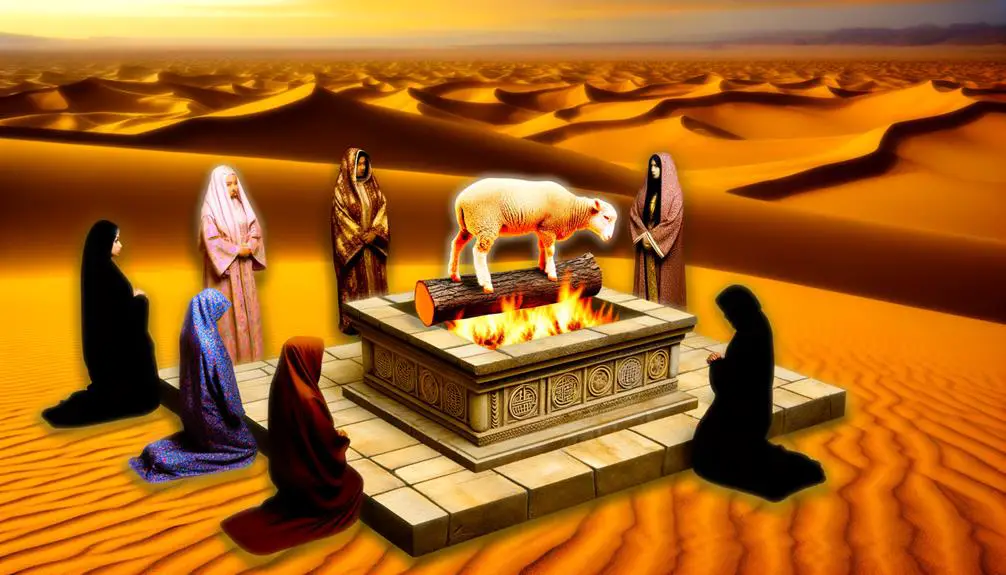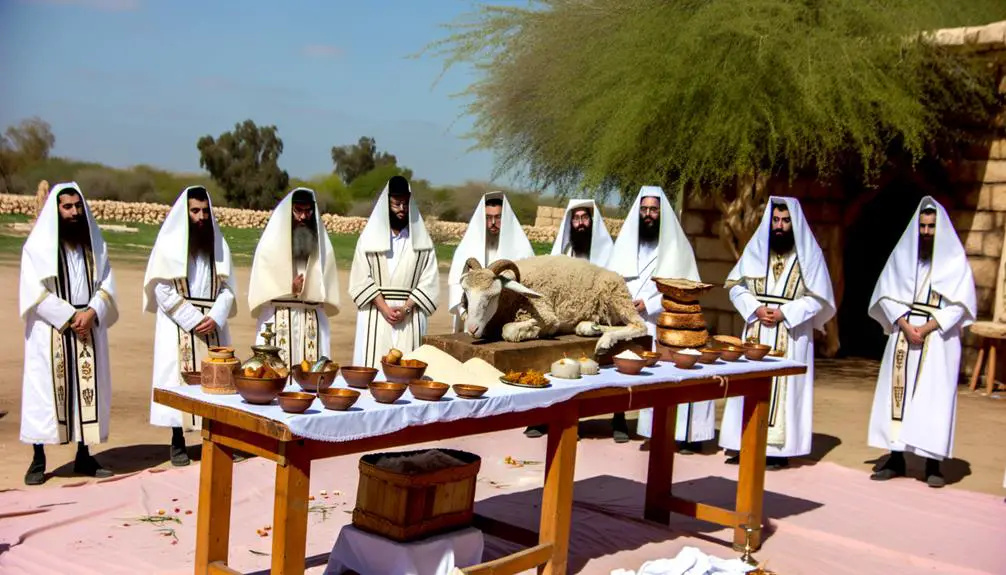Witness the profound meanings behind biblical offerings, from burnt sacrifices to peace offerings, and uncover their enduring impact on faith and worship.

Different Offerings in the Bible
In the Bible, you'll find a variety of offerings that hold deep symbolic meanings rooted in ancient Hebrew worship. Burnt offerings, for instance, were used to atone for sins, involving meticulous procedures outlined primarily in Leviticus. Grain offerings included fine flour and oil, symbolizing purification and dedication, while peace offerings represented reconciliation and thanksgiving to God, reflecting communal unity. Sin offerings addressed unintentional transgressions, aiming to restore holiness within the community. Trespass offerings, involving unblemished rams, catered specifically to violations requiring restitution. Drink offerings, adding a layer of symbolic richness, often used wine to signify life's essence. Exploring these offerings reveals their profound spiritual significance and ongoing impact.
Key Takeaways
- Burnt offerings were used for atonement and purification in ancient Hebrew worship.
- Grain offerings consisted of fine flour, oil, frankincense, and salt, symbolizing dedication and prayer.
- Peace offerings represented reconciliation and thanksgiving, fostering communal harmony.
- Sin offerings facilitated atonement for unintentional sins, restoring purity and holiness.
- Trespass offerings required restitution for specific violations to maintain social and religious order.
Burnt Offerings Explained

Burnt offerings, central to ancient Hebrew worship, were a means by which individuals sought to atone for sins and purify themselves before God. You'll find that in the historical context, these offerings were not unique to the Hebrews but were practiced in various forms across numerous ancient cultures. However, the specific rituals and the symbolism attached to them in Hebrew tradition were distinct.
In exploring these cultural variations, you observe that while surrounding pagan societies often utilized burnt offerings to appease a plethora of gods or to secure material prosperity, the Hebrew approach was deeply intertwined with their covenantal relationship with Yahweh. This relationship was based on obedience and purification, rather than mere transactional or appeasement motives.
The detailed descriptions in the Torah, specifically in books like Leviticus, underscore the solemnity and strict procedures associated with burnt offerings. Animals had to be without blemish, signifying the purity required to approach the divine. This element highlights a profound theological point: the unblemished sacrifice symbolizes the ideal of perfection that is sought in moral and spiritual purification.
Through this lens, you can appreciate how burnt offerings served as a vivid expression of seeking reconciliation with God, fundamentally aimed at restoring the spiritual integrity of the community.
Grain Offerings Unveiled
When delving into the intricacies of grain offerings, it is crucial to understand the specific ingredients used, which primarily include fine flour, oil, and frankincense. Each element serves a distinct purpose, not only in the preparation process but also in enhancing the offering's symbolic significance. By analyzing these components, you'll gain deeper insights into their roles in ritual purity and communal worship within ancient Israelite practices.
Ingredients of Grain Offerings
Grain offerings in the Bible primarily consisted of fine flour, oil, and frankincense, each element symbolically enriching the ritual's significance. You'll notice that the ingredients were not chosen at random; each has deep, symbolic meanings and reflects the agricultural practices and spiritual beliefs of the time.
- Fine Flour: Represents the first fruits of grain varieties, meticulously selected and ground. The choice depended on the harvest timing, ensuring that only the highest quality grains were offered.
- Oil: Symbolizes purification and dedication, typically olive oil, which was a staple product of ancient agriculture.
- Frankincense: Adds a layer of spiritual aroma, signifying prayers rising to the divine.
- Salt: Often included to signify preservation and the enduring covenant between God and Israel.
This precise composition underscores a theology woven deeply into the fabric of daily life and seasonal rhythms.
Preparation Methods
Delving into the preparation methods of grain offerings, you'll find that meticulous steps were integral to ensuring these rituals held deep spiritual significance. In ancient times, the selection of grain was the first critical step, requiring ceremonial cleanliness from the outset. You would observe that specific grains were chosen based on their purity and quality. Moving to the offering locations, these were not chosen at random; locations were often designated sacred spaces, cleansed and prepared in advance to uphold the sanctity of the offerings. The preparation involved grinding the grain finely, a symbol of thorough devotion, and mixed with oil, a practice enhancing the aroma and facilitating the burning process, essential for the acceptance of the offering.
Symbolic Meanings
Throughout history, grain offerings have embodied profound spiritual symbolism, representing elements such as sustenance, thanksgiving, and dedication to divine service. As you explore the ceremonial impacts of these offerings, you'll recognize how they conveyed deep gratitude and reliance on divine provision. Each grain offering wasn't just a ritual act; it was a symbolic dialogue between the divine and the devout.
- Sustenance: Symbolizes life-giving nourishment, metaphorically representing God's provision for His people.
- Thanksgiving: Expresses gratitude for bountiful harvests and personal blessings.
- Dedication: Indicates a commitment to serve and honor the divine will.
- Ceremonial Impact: Enhances communal bonds and reaffirms shared beliefs through structured religious practices.
These elements highlight the multifaceted purposes of offerings, weaving a rich tapestry of faith and devotion.
Peace Offerings Discussed
As you explore the concept of peace offerings in biblical texts, it's important to understand their purpose, which was to symbolize reconciliation and thanksgiving between the offerer and God. The rituals and procedures involved, including the specific parts of the animal used and the accompanying bread, are rich in symbolic meaning, reflecting complex theological ideas about communion and fellowship. Finally, the symbolism embedded in these offerings highlights themes of harmony and restoration, key to grasping their deeper religious and social significance.
Purpose of Peace Offerings
The significance of peace offerings in the Bible primarily symbolizes reconciliation and thanksgiving between you and God. This type of offering serves not only as a gesture of gratitude but also as a means to restore and maintain a harmonious relationship with the Divine. It's fascinating how these offerings encompass both individual and communal dimensions.
- Communal Reconciliation: Peace offerings promote harmony within the community, reflecting a shared commitment to spiritual and social unity.
- Festive Celebrations: They are often part of joyous religious festivals, enhancing the communal experience of worship and gratitude.
- Expression of Thankfulness: Demonstrates your gratitude towards God for blessings received.
- Restoration of Relationships: Aids in mending and strengthening your relationship with God, especially after times of estrangement or sin.
Rituals and Procedures
Understanding the rituals and procedures involved in peace offerings helps you appreciate how these practices facilitate the expression of gratitude and reconciliation detailed earlier. The selection of sacrificial animals was governed by strict criteria, emphasizing ceremonial cleanliness and the absence of blemishes. You'd find that only specific animals, such as cattle, sheep, or goats, were deemed acceptable. Each type of animal had to be meticulously examined to guarantee it met the required standards of purity.
The procedures themselves were equally stringent, involving detailed steps for slaughtering and offering parts of the animal on the altar. These rituals underscored the seriousness with which participants approached the act of making amends or expressing thanks, reinforcing the sacred nature of the peace offerings.
Symbolism in Peace Offerings
Symbolism in peace offerings deeply reflects the community's values and spiritual beliefs, revealing how these rituals serve as a conduit for divine communication and societal cohesion. The offering implications highlight the profound connections between individuals and their worship practices, while also underscoring the communal significance of these acts.
- Reconciliation and Forgiveness: They symbolize the restoration of relationships, both divine and human.
- Thanksgiving and Gratitude: Expressions of deep appreciation towards God for blessings received.
- Promotion of Community Harmony: Encourages unity and shared identity among community members.
- Sanctification and Dedication: Represents a renewal of commitment to spiritual growth and holiness.
These aspects illustrate how peace offerings are not merely ritualistic acts, but are imbued with layers of spiritual and communal meaning.
Sin Offerings Elucidated
In analyzing biblical texts, you'll find that sin offerings were integral to atoning for unintentional transgressions against divine laws. Detailed in Leviticus, these offerings underscore the seriousness with which purity and holiness were regarded in ancient Israelite society. The sin offering, or 'hattat,' wasn't merely a ritual; it was a theological imperative designed to restore the communal equilibrium disrupted by sin.
Central to the efficacy of sin offerings were the priestly roles. Priests acted as intermediaries, facilitating the reconciliation between the individual and the divine. Their duties during these offerings were meticulously outlined, involving specific sacrificial rituals and cleansing processes. These rituals typically involved the sprinkling of blood, which symbolized the purification of the sanctuary from human impurities. This act was not only about expiation—the removal of sin—but also about re-sanctification of the sacred spaces.
The cleansing rituals associated with sin offerings highlight their dual function: purification and deterrence. By engaging in these rituals, the community was constantly reminded of the consequences of sin and the ongoing need for spiritual cleanliness. This dual focus ensured that the sin offerings were not just backward-looking (addressing the sin) but also forward-looking, promoting a culture of vigilance and piety.
Trespass Offerings Detailed

Trespass offerings, described primarily in Leviticus, were essential for atoning specific violations of property or sacred boundaries. You'll find that these offerings were not merely symbolic but were integral to maintaining the social and religious fabric of ancient Israelite society. The process was detailed and required adherence to prescribed rituals to restore both divine and communal harmony.
Here's what you need to understand about trespass offerings:
- Specificity of the Offense: Trespass offerings were required for particular sins, where individuals transgressed against community laws or sacred decrees. This wasn't about general sinfulness but specific acts requiring restitution.
- Ceremonial Guilt and Restitution: The offender had to confess the sin, highlighting the ceremonial guilt aspect. Additionally, restitution involved repaying the full value of the damage plus an additional fifth to the wronged party, underscoring the seriousness of the offense.
- Role of the Priest: The priest played a pivotal role, mediating between the offender and God. This mediation was central to re-establishing the spiritual equilibrium disrupted by the trespass.
- Animal Sacrifice: Typically, a ram without blemish was offered. This sacrifice symbolized the transfer of the offender's guilt to the animal, a critical component of the atonement process.
Understanding these elements sheds light on the complex interplay between divine expectation and communal responsibility in biblical times.
Drink Offerings Analyzed
Drink offerings, often overlooked, were an essential component of ancient worship, intricately linked to sacrifices and communal rituals. You might find it interesting to explore how these offerings weren't just supplementary but held deep symbolic meanings, embodying liquid symbolism. Typically, these offerings consisted of wine, symbolizing life's essence and divine blessing. When poured out, the drink offering represented a total surrender of these blessings back to the deity in acknowledgment of divine sovereignty.
The ceremonial integration of drink offerings with other sacrifices, such as burnt offerings and grain offerings, emphasized a holistic approach to worship. This wasn't merely about following ritualistic procedures; it was a profound expression of theological truths. For instance, the libation of wine on the sacrificial altar wasn't just an act; it signified the pouring out of oneself, reflecting the self-sacrificial aspect of the worshippers' commitment to their faith.
In your exploration of biblical texts, you'll see that the nuances of these practices reflect not only religious obedience but also a communal expression of shared values and unity. The act of pouring out wine, a valuable resource, highlights a community's collective dedication to and dependence upon divine favor and guidance.
Frequently Asked Questions
How Did Offerings Evolve From Old to New Testament Practices?
In examining religious practices, you'll notice sacrificial evolution from Temple rituals in early texts to more symbolic acts in later writings, reflecting a shift towards spiritual rather than physical offerings.
Are Modern Christians Required to Make These Offerings?
You're not required to make traditional offerings; modern Christian practice emphasizes grace implications and faith expressions, viewing giving more as a spiritual discipline reflecting personal commitment rather than a mandatory religious duty.
What Cultural Influences Shaped Ancient Biblical Offerings?
You'd find that ancient rituals were profoundly shaped by regional adaptations, reflecting the diverse cultural landscapes from which they emerged, deeply embedding local customs and beliefs into their ceremonial practices across various civilizations.
How Did Offerings Impact the Socio-Economic Status of Givers?
Offerings reinforced religious power and strengthened community bonds, subtly altering one's socio-economic status. You'd gain respect and potentially more influence within your community, impacting both your social standing and economic opportunities.
Were There Any Offerings Unique to Specific Biblical Festivals?
Yes, specific biblical festivals had unique offerings tied to their festival origins and ritual significance, enhancing their socio-cultural impact and reinforcing communal identity through shared practices and beliefs in ancient religious communities.


Sign up